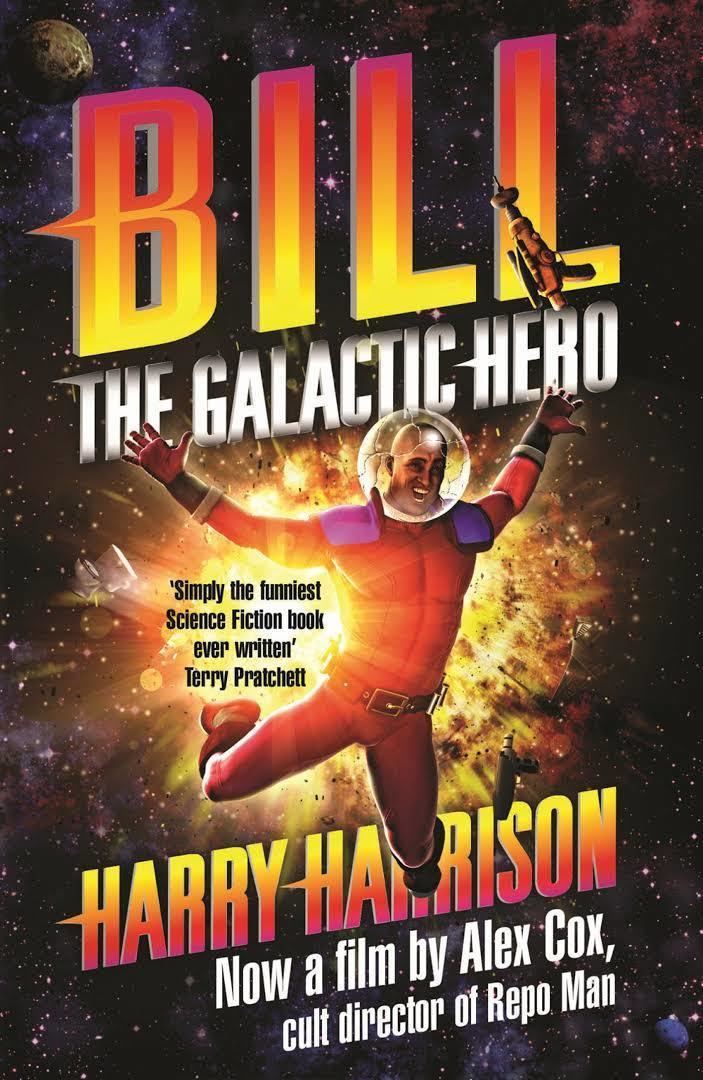7.2 /10 1 Votes7.2
Cover artist Larry Lurin Publication date 1965 Pages 185 Genre Science Fiction OCLC 55999461 | 3.6/5 Goodreads Language English Media type Print () Originally published 1965 Page count 185 | |||||||||||||||||||||||||||||||||
 | ||||||||||||||||||||||||||||||||||
Followed by (Bill, the Galactic Hero) The Planet of the Robot Slaves Similar Works by Harry Harrison, Robert Sheckley books | ||||||||||||||||||||||||||||||||||
Bill the galactic hero
Bill, the Galactic Hero is a satirical science fiction novel by Harry Harrison, first published in 1965.
Contents
Harrison reports having been approached by a Vietnam veteran who described Bill as "the only book that's true about the military."
Plot summary
Bill is a farmboy on a small backward agricultural planet who is drugged, hypnotised, then shanghaied into the Space Troopers and sent to recruit training under a fanged instructor named Deathwish Drang. After surviving boot camp, he is transferred to active duty as a fuse tender on the flagship of the space fleet in battle with the Chingers, a small reptilian race. Injured and with the fleet almost destroyed, he fires off a shot witnessed by an officer and is proclaimed a hero.
As a reward he is sent to the city-planet Helior to receive a medal from the emperor. Bill's city plan is stolen on a sightseeing tour; because it takes him days to get back to the transit centre, he arrives to find himself AWOL and considered a deserter after missing his transport. He escapes and flees into the depths of the city, where he first falls in with a gang of similarly "deplanned" outlaws, then finds employment with Helior's garbage disposal service. His unwilling recruitment as a spy to infiltrate an ineptly-run anarchist plot leads to his arrest.
He is sent to a prison unit working on the planet where the Human-Chinger war continues. Escaping during an attack, he rescues some prisoners and meets a dying Deathwish Drang. He then shoots off his own foot to get off-planet. The book ends with the story coming full circle as Bill, with an artificial foot and Deathwish Drang's fangs, returns to his home planet and recruits his younger brother into the Troopers (A recruiter's term of service is reduced for each new trooper they enlist).
Series
Six sequels were published, from 1989 to 1992:
After this, the sequels were penned by other writers and edited by Harrison. Harry Harrison expressed his own disappointment in the series in an interview with Brian Ireland, quoted on Ireland On-Line.:
They have a thing in the States called 'share cropping' where you have a series or character, and you have other writers do work with it [...] I never wanted to do it, I'm not interested. But one of the packagers said, coming back to this thing I said about the pornography of violence: Harry, why don't we do a Bill, the Galactic Hero series and actually do some anti-war propaganda instead of all pro war. So they eventually talked me into it. The second one — Bill, the Galactic Hero on the Planet of Robot Slaves — I did myself, that was a lot of fun. If they could all be like that. But no, no. We all make mistakes. I'm a professional writer. I earn a living at it. These are the only ones where I did it wrong.
"Bill, the Galactic Hero's Happy Holiday" appeared as a short story in Galactic Dreams (1994) by Harry Harrison
Bloater Drive
The standard ways of circumventing relativity in 1950s and 1960s science fiction were hyperspace, subspace and spacewarp. Harrison's contribution was the "Bloater Drive". This enlarges the gaps between the atoms of the ship until it spans the distance to the destination, whereupon the atoms are moved back together again, reconstituting the ship at its previous size but in the new location. An occasional side-effect is that the occupants see a planet drifting, in miniature, through the hull.
Bowb
Harrison introduced a new euphemism, "bowb", in the series to cover the vulgarity necessary to render military life accurately. It is used extensively in Bill, the Galactic Hero.
Film adaptation
According to filmmaker Alex Cox, Bill, the Galactic Hero was optioned in the mid-1980s, but never came to fruition as a film project. Prior to his death in 2012, Harrison gave Cox "academic license" to make a student film version of the novel with his students at the University of Colorado at Boulder. In March 2013, Cox launched a Kickstarter campaign, hoping to raise a goal of $100,000 to shoot the film. Cox succeeded in raising in excess of the budget and in getting a number of film professionals to work on a royalties basis. The film went into production in October 2013 and premiered in Boulder on 12 December 2014 to positive reviews.
